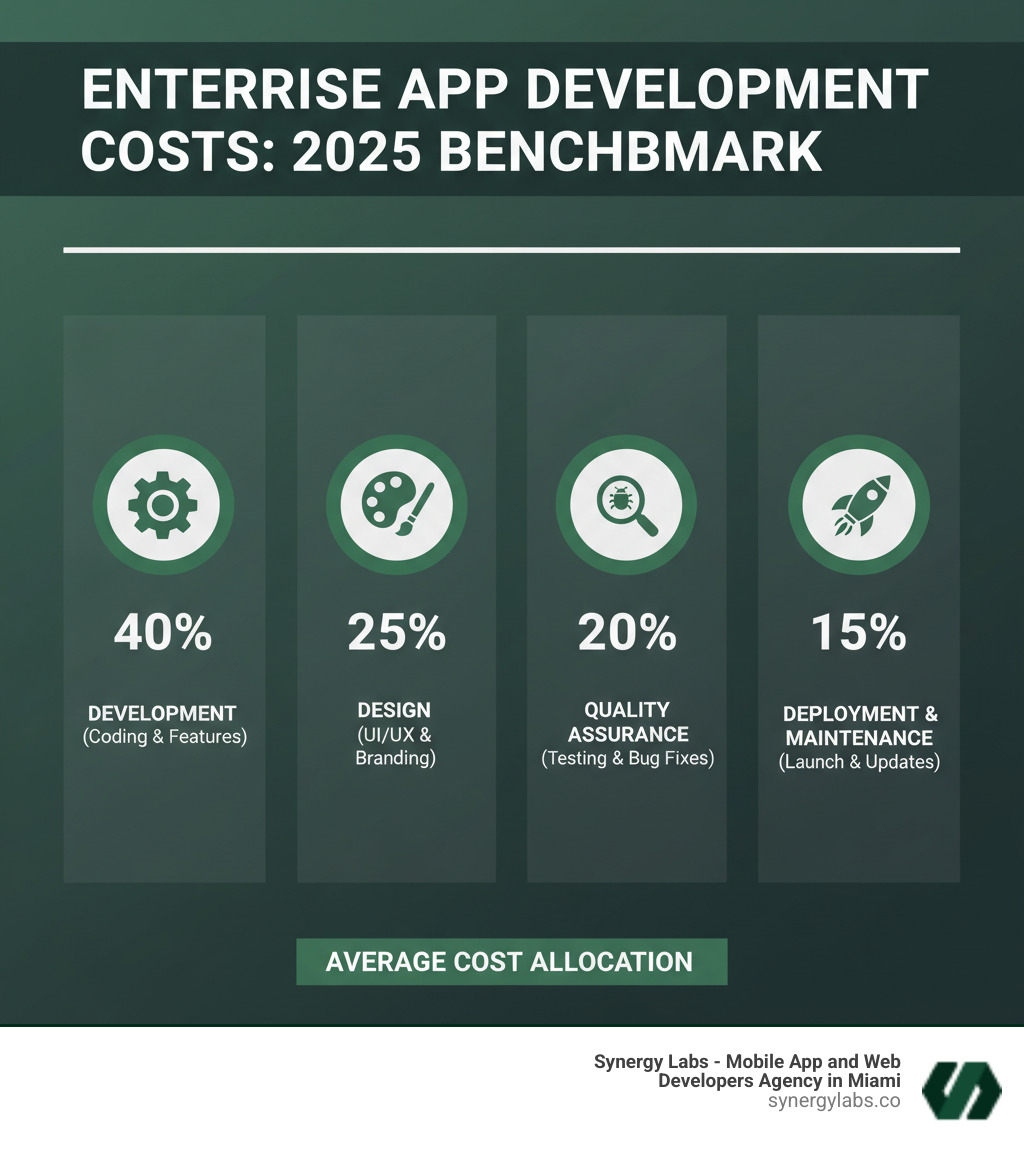Сотрудничайте с агентством TOP-TIER
Запланируйтевстречу через форму здесь, и
мы соединим вас напрямую с нашим директором по продукции - никаких продавцов.
Предпочитаете поговорить сейчас?
Позвоните нам по телефону + 1 (645) 444 - 1069

"Understanding what drives cost and what's realistic can mean the difference between success and a budget disaster."

The Cost of Enterprise-Grade App Development: 2025 Benchmark Guide is essential for any business leader planning a major digital investment. Understanding what drives cost and what's realistic can mean the difference between success and a budget disaster.
Here's what you need to know right now:
Many companies underestimate development costs, leading to delays and budget overruns. The average cost of creating an app is around $172,000, but enterprise-grade solutions often exceed that significantly. Without a solid cost estimate, you're flying blind.
The global mobile app market is projected to reach $407 billion by 2025, and companies are investing heavily in custom software. But app development is a strategic investment shaped by technology stacks, AI integrations, and long-term scalability plans, not just features.
Enterprise apps have high stakes, requiring robust authentication, role-based access, scalability, and advanced analytics. They must often comply with HIPAA or GDPR and integrate seamlessly with existing systems like ERP and CRM platforms, which adds significant cost.
Key cost drivers in 2025 include:
At Synergy Labs, we've built enterprise-grade apps for a diverse range of clients, helping them scale to millions of users. Our experience has taught us that the best projects start with realistic budgeting. Let's break down what you're paying for and how to optimize every dollar.

The Cost of Enterprise-Grade App Development: 2025 Benchmark Guide vocab to learn:
Understanding The Cost of Enterprise-Grade App Development: 2025 Benchmark Guide is about knowing the key decisions that influence your final investment. The main factors are app complexity, platform choice, UI/UX design, backend infrastructure, and security measures. Each element has its own cost structure, and understanding them upfront prevents surprises. For a comprehensive look, see The Complete Guide to App Development for Enterprise Solutions in 2025.

This is the single biggest factor in your budget. A simple internal tool is vastly different from a sophisticated, AI-driven platform.
Simple features like user registration, basic profiles, and push notifications ($1,000–$3,000) are foundational and relatively straightforward.
Advanced features are where enterprise apps earn their price tag. Secure user authentication can add $5,000–$10,000. Payment gateway integration costs $2,500–$7,000, and real-time chat tools can run $10,000–$20,000. Emerging technologies drive costs higher: AI/ML integration can range from $30,000 to over $500,000, AR features from $20,000 to $150,000, and IoT connectivity from $80,000 to $250,000+. Each third-party API integration with a CRM or ERP adds another $10,000–$30,000.
Enterprise apps typically require several of these advanced features to deliver business value, which is why they cost more than consumer apps.
Your platform choice shapes your timeline and budget. We help clients steer this decision daily through our App Development Service.
Native (iOS and Android) development offers the best performance and user experience but requires building and maintaining two separate codebases. This approach is typically 25-40% more expensive than cross-platform alternatives.
Cross-platform development allows you to write one codebase for multiple platforms, cutting costs by 30-40% and speeding up time-to-market. For most enterprise solutions, performance trade-offs are minimal, and the efficiency gains are significant.
Progressive Web Apps (PWAs) are the most cost-effective option at $20,000–$80,000. They run in a browser, offering wide reach but limited device integration and offline capabilities.
For most enterprise projects, we recommend cross-platform development for its balance of quality, cost, and speed.
Your app's technical infrastructure is a major, sometimes overlooked, cost driver.
UI/UX design is about usability. While basic design starts around $5,000, enterprise-grade apps with complex workflows require a $15,000–$30,000+ investment to ensure high user adoption.
Backend development is your app's brain, handling data, user management, and logic. It typically costs $5,000–$50,000+, depending on complexity. This includes your cloud hosting choices, database architecture, and API development to connect with other systems like ERP and CRM platforms.
Security measures are non-negotiable. Robust data encryption, multi-factor authentication, and regular security audits are baseline requirements. Compliance with regulations like HIPAA or GDPR can add $10,000 or more in legal and security fees. We recommend allocating 10-15% of your total budget to security. Learn more about our approach in Chicago's Competitive Edge: Building Secure Enterprise Apps in the Midwest.
Planning an enterprise app requires concrete numbers. The Cost of Enterprise-Grade App Development: 2025 Benchmark Guide provides them based on real-world projects. While the global app market sees billions of downloads, enterprise solutions are different. They demand bulletproof security, seamless integrations, and scalability.
Unlike consumer apps, enterprise applications are workhorses that handle sensitive data and support thousands of users. This fundamental difference is why their costs are significantly higher.

Complexity is about how features interact and connect to your infrastructure. We break enterprise apps into three tiers to help clients budget effectively.
Budget allocation is typically as follows: development (40-55%), UI/UX design (20-25%), findy and planning (10-15%), QA and testing (15-20%), and deployment (5-10%).
Geography dramatically impacts hourly rates, communication, and project management.
Synergy Labs offers a hybrid model with offices in Miami, Chicago, New York, and other global hubs. We place senior strategists near you for collaboration while leveraging talented global teams for implementation. This gives you top-tier service and competitive budgeting—quality and cost, combined.
Your industry adds another layer of cost due to regulations and specific integration needs.
Our cross-industry experience helps clients steer these specialized requirements. For more insights, see The Definitive Guide to Digital Transformation Services for Mid-Sized Enterprises in 2025.
Choosing who builds your app is a strategic decision that shapes its success, timeline, and cost. The right team turns your vision into reality on budget; the wrong one leads to overruns and missed opportunities. For guidance, read The Ultimate Guide to Choosing an Enterprise Mobile App Development Company in 2025.
Regarding The Cost of Enterprise-Grade App Development: 2025 Benchmark Guide, your first decision is whether to build in-house or outsource.
A quality development partner costs more upfront but saves money long-term by delivering a scalable, secure, and bug-free application.
How you structure the engagement impacts budget predictability and project flexibility.
We believe in collaborative budgeting, working with you to choose the engagement model that best serves your project's success.
When considering The Cost of Enterprise-Grade App Development: 2025 Benchmark Guide, launch isn't the finish line. Your app will require ongoing investment, known as the "total cost of ownership" (TCO). With smart planning, you can manage these costs effectively. Learn more in How Growing Businesses Can Leverage Custom Apps Without Breaking the Bank in 2025.

After your app goes live, you must budget for its upkeep.
Annual maintenance typically runs 15-25% of your original development cost. For a $200,000 app, that's $30,000 to $50,000 per year. This essential work covers:
Other recurring costs include server/hosting fees, third-party licenses ($1,000 to $10,000/year), app store fees (developer program fees are typically $99-$299/year), and user support ($2,000 to $10,000/year). Don't forget to budget for marketing and launch campaigns ($5,000+).
While the costs are real, so are the benefits. For most businesses, the return on investment is significant.
At Synergy Labs, we help clients calculate ROI from the start. We dig deep into these calculations in The ROI of Enterprise App Development: What C-Level Executives Need to Know. An enterprise app is an investment that should pay dividends for years to come.
When discussing The Cost of Enterprise-Grade App Development: 2025 Benchmark Guide, a few key questions always arise. Here are the direct answers.
There is no single average, as costs vary dramatically with complexity. However, a realistic budget for most enterprise applications falls between $150,000 and $750,000+.
Simple internal tools might start around $60,000, but they are the exception. Large-scale platforms with advanced AI, extensive integrations, or heavy compliance needs can easily exceed $1 million. Enterprise solutions demand robust security, scalability, and integration, which justifies the higher investment compared to consumer apps.
Yes, absolutely. Cross-platform development typically reduces initial costs by 20-40% compared to building separate native apps for each major platform. This is achieved by using a single codebase, which also speeds up time-to-market and simplifies maintenance.
For a project that might cost $300,000 as two native builds, a cross-platform approach could bring the cost down to the $180,000-$240,000 range. While native development is still preferred for apps requiring maximum performance or deep hardware access, modern cross-platform technology is more than sufficient for the vast majority of enterprise use cases.
You should budget 15-25% of your initial development cost annually for ongoing maintenance and support. This is a critical, non-negotiable expense.
For an app that cost $200,000 to build, plan for an additional $30,000 to $50,000 per year. This budget covers essential activities like bug fixes, security patches, compatibility updates for new operating systems, server hosting, and performance monitoring. Skimping on maintenance leads to security risks, poor user experience, and eventually, the need for a costly rebuild.
The Cost of Enterprise-Grade App Development: 2025 Benchmark Guide is about making a strategic investment that delivers measurable value. We've covered the key factors, from feature complexity and platform choice to team models and ongoing costs. Strategic planning, a clear MVP, and a deep understanding of cost drivers are your best defense against budget overruns.
At Synergy Labs, we build long-term partnerships with our clients. As a top-tier mobile app development agency, we specialize in creating high-quality, scalable, cross-platform apps. Our distinction lies in personalized service with direct access to senior talent—not junior developers. We are committed to rapid launches, ongoing support, user-centered design, and robust security. In 2025, future-proofing your application is essential.
The digital landscape demands a powerful, secure, and scalable solution that moves your business forward. Armed with the knowledge from this guide, you can make informed decisions. Partnering with a reliable expert who understands the enterprise space will make your app a cornerstone of your success. Ready to turn your vision into a reality with a clear, transparent estimate? Explore Our Services today and let's talk.

Начать работу очень просто! Просто свяжитесь с нами, поделившись своей идеей через нашу контактную форму. Один из членов нашей команды ответит в течение одного рабочего дня по электронной почте или телефону, чтобы подробно обсудить ваш проект. Мы будем рады помочь вам воплотить ваше видение в реальность!
Выбор SynergyLabs означает сотрудничество с высококлассным бутиковым агентством по разработке мобильных приложений, которое уделяет первостепенное внимание вашим потребностям. Наша команда, полностью базирующаяся в США, занимается разработкой высококачественных, масштабируемых и кроссплатформенных приложений быстро и по доступным ценам. Мы уделяем особое внимание индивидуальному подходу, гарантируя, что на протяжении всего проекта вы будете работать непосредственно с высококлассными специалистами. Наша приверженность инновациям, удовлетворенность клиентов и прозрачная коммуникация отличают нас от других агентств. С SynergyLabs вы можете быть уверены, что ваше видение будет воплощено в жизнь со знанием дела и заботой.
Обычно мы запускаем приложения в течение 6-8 недель, в зависимости от сложности и особенностей вашего проекта. Наш оптимизированный процесс разработки гарантирует, что вы сможете быстро вывести приложение на рынок и при этом получить высококачественный продукт.
Наш метод кроссплатформенной разработки позволяет нам создавать одновременно веб- и мобильные приложения. Это означает, что ваше мобильное приложение будет доступно как на iOS, так и на Android, обеспечивая широкий охват и беспроблемный пользовательский опыт на всех устройствах. Наш подход поможет вам сэкономить время и ресурсы и при этом максимально раскрыть потенциал вашего приложения.
В SynergyLabs мы используем различные языки программирования и фреймворки, чтобы наилучшим образом удовлетворить потребности вашего проекта. Для кроссплатформенной разработки мы используем Flutter или Flutterflow, которые позволяют эффективно поддерживать веб, Android и iOS с помощью одной кодовой базы - идеальный вариант для проектов с ограниченным бюджетом. Для нативных приложений мы используем Swift для iOS и Kotlin для Android.




Для веб-приложений мы сочетаем такие фреймворки для верстки фронтенда, как Ant Design или Material Design с React. Для бэкенда мы обычно используем Laravel или Yii2 для монолитных проектов и Node.js для бессерверных архитектур.






Кроме того, мы можем поддерживать различные технологии, включая Microsoft Azure, Google Cloud, Firebase, Amazon Web Services (AWS), React Native, Docker, NGINX, Apache и другие. Такой разнообразный набор навыков позволяет нам создавать надежные и масштабируемые решения, отвечающие вашим конкретным требованиям.








Безопасность - наш главный приоритет. Мы применяем стандартные меры безопасности, включая шифрование данных, безопасное кодирование и регулярные аудиты безопасности, чтобы защитить ваше приложение и данные пользователей.
Да, мы предлагаем постоянную поддержку, обслуживание и обновления для вашего приложения. После завершения проекта вы получите до 4 недель бесплатного обслуживания, чтобы обеспечить бесперебойную работу. После этого периода мы предоставляем гибкие варианты постоянной поддержки в соответствии с вашими потребностями, чтобы вы могли сосредоточиться на развитии своего бизнеса, пока мы занимаемся обслуживанием и обновлениями вашего приложения.